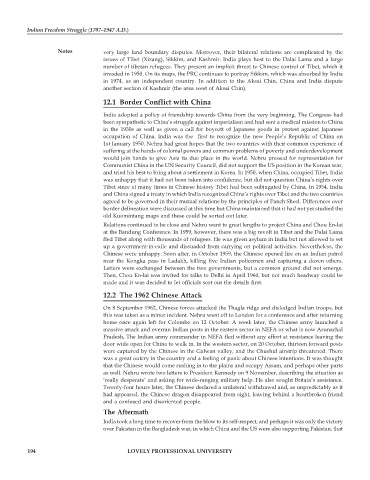Page 199 - DHIS204_DHIS205_INDIAN_FREEDOM_STRUGGLE_HINDI
P. 199
Indian Freedom Struggle (1707–1947 A.D.)
Notes very large land boundary disputes. Moreover, their bilateral relations are complicated by the
issues of Tibet (Xizang), Sikkim, and Kashmir. India plays host to the Dalai Lama and a large
number of tibetan refugees. They present an implicit threat to Chinese control of Tibet, which it
invaded in 1950. On its maps, the PRC continues to portray Sikkim, which was absorbed by India
in 1974, as an independent country. In addition to the Aksai Chin, China and India dispute
another section of Kashmir (the area west of Aksai Chin).
12.1 Border Conflict with China
India adopted a policy of friendship towards China from the very beginning. The Congress had
been sympathetic to China’s struggle against imperialism and had sent a medical mission to China
in the 1930s as well as given a call for boycott of Japanese goods in protest against Japanese
occupation of China. India was the first to recognize the new People’s Republic of China on
1st January 1950. Nehru had great hopes that the two countries with their common experience of
suffering at the hands of colonial powers and common problems of poverty and underdevelopment
would join hands to give Asia its due place in the world. Nehru pressed for representation for
Communist China in the UN Security Council, did not support the US position in the Korean war,
and tried his best to bring about a settlement in Korea. In 1950, when China, occupied Tibet, India
was unhappy that it had not been taken into confidence, but did not question China’s rights over
Tibet since at many times in Chinese history Tibet had been subjugated by China. In 1954, India
and China signed a treaty in which India recognized China’s rights over Tibet and the two countries
agreed to be governed in their mutual relations by the principles of Panch Sheel. Differences over
border delineation were discussed at this time but China maintained that it had not yet studied the
old Kuomintang maps and these could be sorted out later.
Relations continued to be close and Nehru went to great lengths to project China and Chou En-lai
at the Bandung Conference. In 1959, however, there was a big revolt in Tibet and the Dalai Lama
fled Tibet along with thousands of refugees. He was given asylum in India but not allowed to set
up a government-in-exile and dissuaded from carrying on political activities. Nevertheless, the
Chinese were unhappy. Soon after, in October 1959, the Chinese opened fire on an Indian patrol
near the Kongka pass in Ladakh, killing five Indian policemen and capturing a dozen others.
Letters were exchanged between the two governments, but a common ground did not emerge.
Then, Chou En-lai was invited for talks to Delhi in April 1960, but not much headway could be
made and it was decided to let officials sort out the details first.
12.2 The 1962 Chinese Attack
On 8 September 1962, Chinese forces attacked the Thagla ridge and dislodged Indian troops, but
this was taken as a minor incident. Nehru went off to London for a conference and after returning
home once again left for Colombo on 12 October. A week later, the Chinese army launched a
massive attack and overran Indian posts in the eastern sector in NEFA or what is now Arunachal
Pradesh, The Indian army commander in NEFA fled without any effort at resistance leaving the
door wide open for China to walk in. In the western sector, on 20 October, thirteen forward posts
were captured by the Chinese in the Galwan valley, and the Chushul airstrip threatened. There
was a great outcry in the country and a feeling of panic about Chinese intentions. It was thought
that the Chinese would come rushing in to the plains and occupy Assam, and perhaps other parts
as well. Nehru wrote two letters to President Kennedy on 9 November, describing the situation as
‘really desperate’ and asking for wide-ranging military help. He also sought Britain’s assistance.
Twenty-four hours later, the Chinese declared a unilateral withdrawal and, as unpredictably as it
had appeared, the Chinese dragon disappeared from sight, leaving behind a heartbroken friend
and a confused and disoriented people.
The Aftermath
India took a long time to recover from the blow to its self-respect, and perhaps it was only the victory
over Pakistan in the Bangladesh war, in which China and the US were also supporting Pakistan, that
194 LOVELY PROFESSIONAL UNIVERSITY

